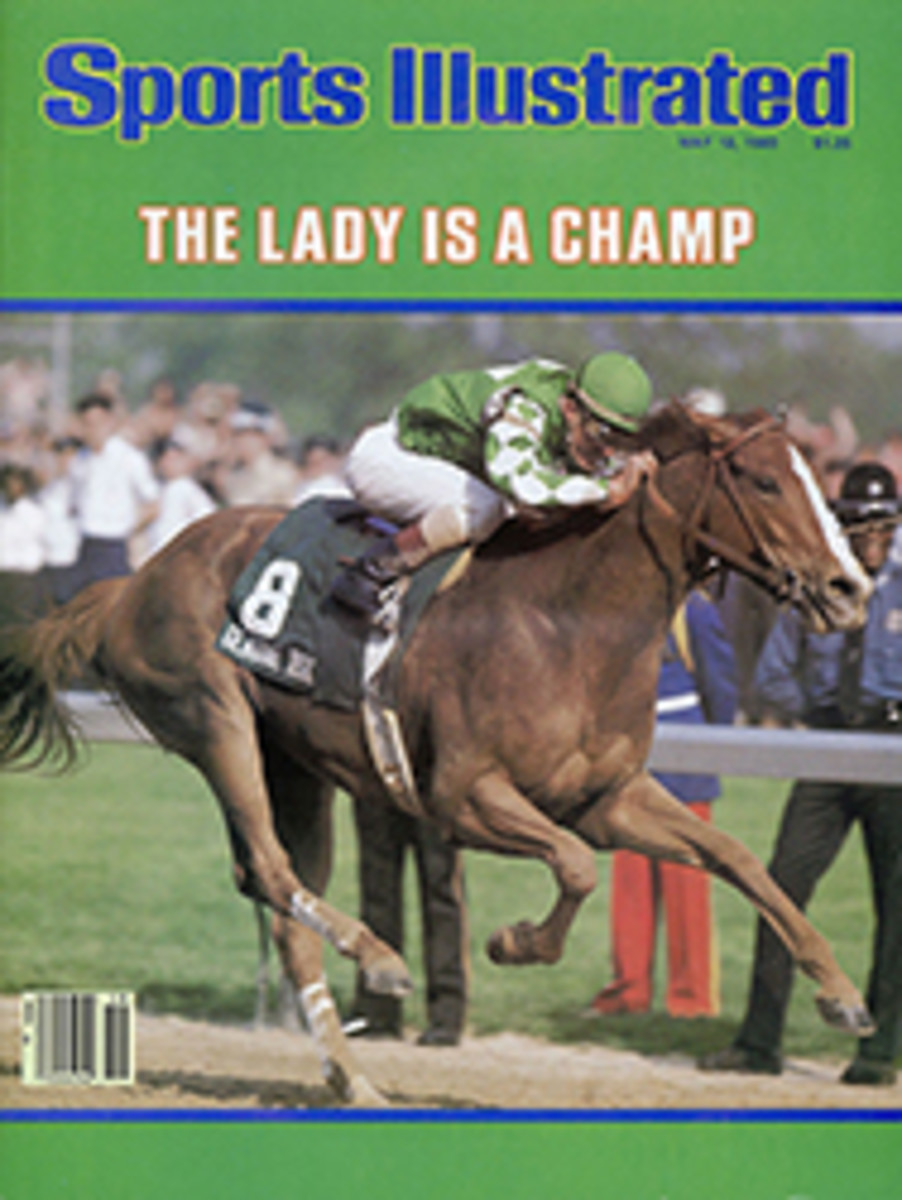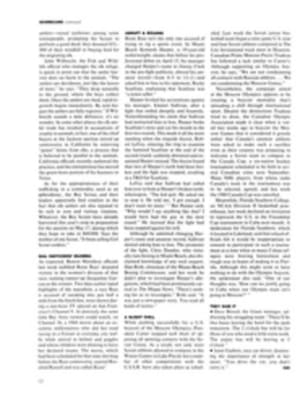
He's not a man to take it lying down
It was kind of a sidewinder's duel—this battle to be the best, uh, lefthanded player in the world. There they were, the two deadliest gunslingers in town, 20 paces apart. One had been waiting for the other a long while. Both knew it would come down to this. Him or me. The streets were empty. It was time. High Noon in Dallas. All Jimmy Connors and John McEnroe needed last Sunday afternoon was Tex Ritter singing. In the World Championship Tennis finals the question was not who was the good guy, who the bad guy. It was who was the baddest.
McEnroe's usurpation of the lead villain's role came nearly a year and a half ago, just about the time Connors was turning into a husband and a father—and a human being. Connors wears a lighter shade of hat now, and after his 2-6, 7-6, 6-1, 6-2 victory in Big D, the third time he has defeated his younger rival in four meetings this year, it seems he may be wearing McEnroe's number as well.
"I don't want to hear about No. 2," Connors said after he had twice clutch-served to save the key second set; after he had roared to the attack to manufacture an errorless tie-breaker, which he won 7-4; and after he had slashed away from the backcourt as of old to completely dominate the bewildered Junior in the final two sets. "There's only one number. This is just a step up the ladder."
In his single-minded determination to catch Bjorn Borg, who wasn't in Texas, Connors has been doggedly pushing himself in workouts, picking his tournament spots and honing his game, with the result that he has become more conservative, adaptable, patient, in control. When McEnroe blasted five aces in the first set, permitting only four points against service, Connors relaxed and looked for other openings.
Immediately, he broke Junior in the first game of the second. "I realized I could return his stuff," Connors said. "I waited for my exact shot. Then I took chances. Right away I lifted my game."
The tie-breaker turned on a backhand torpedo by Connors that McEnroe could not handle at net—5-3 to Jimbo—following which Connors won it by spinning a nifty serve of his own down the middle, which McEnroe returned wide. That, essentially, was it.
For the new champion, whose weight and penetration of shot recalled his 1976 U.S. Open victories over Guillermo Vilas and Borg—Connors' days of wine and roses—this championship signaled something very special.
"I'm not exactly going into retreat formation," he said. "I was gnawing and clawing out there. Mac wanted to know what I was like in my prime. Well...."
Connors thus became the second player in the WCT showdown's 10 years of existence to win the event twice. In that decade it has become one of the five or six most prestigious tournaments in tennis because of its dynamic final matches. This has happened even though WCT's founding brother, Lamar Hunt, decided early on to locate his pet project at an arena generally associated with basketball in a town generally associated with football and on a weekend generally associated with horse racing. Of course, the Hunts have been known to gamble the, uh, silverware on just about anything. But this bet paid off. Mention "Dallas" in tennis circles and everybody knows what you mean.
Ken Rosewall and Rod Laver brought WCT-Dallas instant notoriety back in 1971 and 1972 by playing two classic finals, both of which Rosewall won, the latter climaxed by a fifth-set tie-breaker that is still considered one of the game's most dramatic moments. In 1974 a skinny, brittle teen-ager with a discus thrower's forehand stunned WCT-Dallas by reaching the first of what would be many major finals and taking a set off John Newcombe. He was 17. His name was Bjorn Borg. Then last May, McEnroe burst from the cocoon and accomplished the somewhat amazing feat of defeating Connors and Borg in successive matches to win yet another landmark WCT.
How's that for history? Or how's this? Nobody ever won Dallas without first having won either a Grand Slam title or the Grand Prix Masters. Indeed, the WCT roster of winners reads like a Who's Who of the sport over the past decade: Smith, Newcombe, Ashe, Borg, Connors, Gerulaitis.
This year Hunt enlarged his event in a couple of ways, with mixed results. By moving out of Moody Coliseum, the cozy little (9,000 seats) brick shack on the SMU campus, and into the glistening new Reunion Arena, closer to downtown and hard by a glamorous high-rise hotel complex, WCT nearly doubled its seating capacity. By beginning the matches on Monday night, WCT stretched what is basically a four-day tournament to an unduly long seven days. Given the field of Connors, McEnroe and six other fellows who might have arrived in Big D under cover of darkness for all anybody cared, a four-hour tournament is what it would turn out to be.
Simply because there is so much tennis money floating around, so many tournaments and, more to the point, so many of what the players refer to as "four-mans"—which are nothing more than half-effort exhibitions stacked with upfront appearance dollars—many of the name players chose to skip many of the eight WCT qualifying events.
Borg and Roscoe Tanner played in one apiece. Thanks a lot, boys. Harold Solomon, Gene Mayer and the P.E. (Prince of Exhibitions), Victor Pecci, made all of two. The improving Spaniard, Jose Higueras, showed up for three. While Vilas, Wojtek Fibak, Stan Smith, Eddie Dibbs, Brian Gottfried and Vitas Gerulaitis played in four WCT tournaments, they didn't exactly sweat to make Dallas when push came to shove.
Connors and McEnroe were old hands in the WCT finals, but the other six players were newcomers. Because all of them will be around long after Ilie Nastase has dropped his pants for the last time, here are capsule biographies of Dallas' Secret Six.
•Vijay Amritraj. Middle of three tennis-playing brothers from Madras, India. Only 26, has been around nearly as long as Indira Gandhi, a family friend. Enjoying best year since 1973 when reached quarterfinals of Wimbledon and U.S. Open as teen-ager. Has beaten Connors, Gerulaitis, Vilas and Dibbs of Top Ten. Graceful, elegant, popular. Not exactly brimming with dedication. Pulls out of tournaments with "mental fatigue." Probably from Hollywood parties. Runs with Vince Van Patten, Farrah, that crowd. Squired Star Trek's Persis Khambatta to Academy Awards. Lives in Marina Del Rey. You get the picture. Wouldn't be caught dead in a madras jacket.
•John Sadri. The 1978 NCAA runner-up to McEnroe. Entered court wearing blazer, cowboy hat and vestiges of shaved-head Mohawk look to standing O from classmates at North Carolina State. Served 24 aces. At 23, a late bloomer, or boomer. Finalist in Australian Open, semifinalist at Pro Indoors in Philly. Arnold Schwarzenegger in tennis whites. A monster server who goes for it on second delivery as well. Still too stiff on the volley. Off court, explores caves and drives Ferrari 142 mph. Almost as fast as serve. Known as "the Mad Marine" or "GI Joe." McEnroe says, "A funky, Southern, maniac, macho dude."
•Ivan Lendl. Whisper this: the next great player. Barely 20, out of Ostrava, Czechoslovakia. Not connected to the Prague contingent of Jan Kodes and all those Czech women—Navratilova, Marsikova, Tomanova, Mandlikova. At Washington Indoors beat Tanner but blew lead in final to Victor Amaya. Last month blitzed field—Higueras, Gottfried, Dibbs—to win Houston on clay without losing set. Vicious, flaming forehand. Dangerous backhand pass. Solid technique all around, just lacks strategy. Tall (6'2"), gangly; clipped hair of a punk rocker. Pronounces first name "Evonne." Wears funny two-tone, beige-and-yellow sneakers with black laces, two wristbands per wrist ("I am sweating so much"), striped shirts like cyclist. If he passes up Tour de France, will be real threat on European dirt this summer.
•Heinz Gunthardt. Came yodeling out of Zurich in 1976 as best junior in world, then ran in place for long time. Handsome, articulate and 21 years old. Rumor was he signed with Mark McCormack too early. Fell in love with money and self. Plastered name on car, drove through Alps countryside, became household name across those mountains. Stylish, rangy, but undisciplined, flaky. In 1978 at Springfield, Mass. became only player ever to be defeated in qualifying, get in main draw as substitute and then win tournament as "lucky loser." Last week appeared lucky to be alive after McEnroe put so many holes through him (6-2, 6-1, 6-0) he could have passed for Swiss cheese.
•Bill Scanlon, 23. Dallas' own. Richardson High School's own. Has made career out of whipping Peter Fleming in tournament finals: 1976 NCAAs, 1978 Maui, 1979 Maui. Players say he bears down in Hawaii, relaxes everywhere else. Seems confused. Natural, flowing strokes. Magnificent backhand. Gives away ton of points with casual demeanor. Guitar-playing has earned him friends in music world such as George Benson, the Eagles. "Billy the Kid is riding again on the plains of Texas," he said before taking Connors to two tie-breakers in Dallas. But—no hula skirts, no inspiration—he came up empty, just as he did to same man in Wimbledon quarterfinals last summer. One of these nights....
•Johan Kriek. Prince Valiant with sneer. Barrel-chested, 22-year-old South African left the Transvaal, followed coach to Austria as teen. Big first serve for short guy, bigger first volley. In 100-yard dash for tennis players, pick him. Never out of a point. Astounding quickness displayed at U.S. Open, in which he lost to Gerulaitis in quarters both of last two years. Arrogant, petulant, bad temper on court. At Open yelled to umpire Jason Smith, "Come down from that chair and I'll punch your face." Attitude apart, one of neatest players in game to watch.
Last week after Kriek dismantled Sadri's serve in straight sets and after Lendl positively enthralled Amritraj in straights—"I've never been passed like that in my life," said the Indian—the two youngsters came head-on into semifinal battles with McEnroe and Connors.
Alas, on Friday afternoon Lendl never changed pace against Connors, electing to slug it out from the backcourt. He also kept attempting to hit winners from the worst possible places, and he was beaten 6-4, 7-5, 6-3.
Kriek, having split sets with McEnroe despite 10 double faults, got on top of his seemingly disinterested opponent 5-1, 30-0 in the third set before everything came unglued. McEnroe began nailing winning returns. Kriek got too anxious and began popping up volleys. Junior broke from deuce. He broke again at 15. Soon they were in a tie-breaker and, after a disputed point was awarded to McEnroe, he went on to win the extra session 7-3, and the match 6-4, 4-6, 7-6, 6-3.
McEnroe has been struggling in recent weeks, fostering the impression that he may have played too much tennis in the first four months of the year. "I have a hard time getting up for my matches," he admitted. "I've played so many tournaments, they all seem the same now."
Connors, however, realized that Dallas was Dallas. Last year Jimbo didn't get past the semifinals of any major tournament, and McEnroe routed and embarrassed him here. Now Connors was lean and hard. He was practicing more diligently than ever. With wife Patti and baby Brett (a 9-month-old boy) cheering him on, his mind was clearer. "I've got my game just about where I'm satisfied," Connors said. "Of course I'm not satisfied with anything short of perfect."
That being so, his performance on Sunday was just about satisfactory.
PHOTO
Since marrying and becoming a dad, Connors—here doing his Buster Mathis imitation—has picked himself up, brushed himself off and started winning again.
PHOTO
In the final, Jimbo's game had Junior agape.

